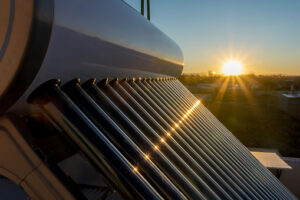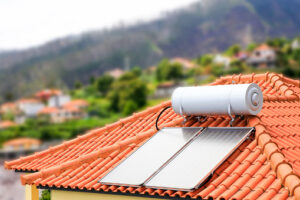Solar hot water systems are a great way to reduce your energy bills and help the environment. But how much do they cost? And what are the benefits of solar hot water systems? It can be challenging to determine the cost of solar hot water, as several factors go into the price.
However, in this post, we will do our best to estimate what you can expect to pay for a system. Also, we’ll take a look at some of the costs associated with installing solar hot water heating, as well as some of the benefits you can expect. Keep in mind that prices vary depending on your location and the size and type of system you choose. So, let’s get started.

One-Time Costs For Solar Power Hot Water System
Installing a solar water heater is not cheap. Homeowners spend an average of $3,500 on installation and other costs of having this type installed in their homes. But there are some high-end models which can cost as much as $13k.
The cost of a solar hot water system can vary greatly depending on the type and size collector chosen. Bulk collectors are priced at $500 while evacuated tubes or flat plates may be upwards up to $2k, with tanks adding $150-200 in equipment prices before labor is factored into it all for a combined total between $1000 – 1500. And an additional $1000 if you want a backup solar water heater.
Operating Costs Of Solar Hot Water Systems
When deciding to invest in solar water heating, homeowners or businesses alike need to know how much their system will cost after purchasing. Systems come with different price tags and features which can affect what kind of savings one might experience over time. So, estimate both annual operating costs and average monthly on-going costs for analysis.
You need to understand:
- The solar energy factor of the system (SEF)
- The auxiliary tank fuel type and costs
You can expect to pay around $100-200 for annual maintenance, but the costs will increase depending on the size and model of solar water heaters you’ve got.
Types Of Systems Along With Cost
Some types of solar hot water heater systems along with benefits and costs include:
1. Solar Water Heater Passive System Cost
Passive solar water heating systems are typically less expensive than active solar water heating systems because they require fewer components. The cost of the system will depend on your geographic location, where you get the parts, and whether or not you choose to hire a contractor.
Many homeowners that have an existing house with good insulation values can build get passive solar hot water heating systems for around $1,000-$3,000 installed.
2. Active Solar Heater Systems Cost
Active solar water heater systems cost more to install than passive systems, but they also save money by using electricity or gas to move the heat from a collector to a storage unit. Active systems can provide about twice as much hot water as passive ones in most cases. You can expect to pay around $2000-4000 for such systems.
The basic components in an active solar heating system are:
- A hot water storage tank and a backup storage tank if needed
- Pumps and controllers to circulate fluid through collectors and storage tanks
- Heat exchangers for transferring heat between fluids (e.g., antifreeze)
- Valves for isolating parts of the system that need repair or maintenance
- All necessary pipes, wiring, and ducts for connecting these components together
3. Heat Pump Systems Cost
A heat-pump system is a common type of active solar water heating system. Heat pumps are a very cost-effective solution and can be installed in both new and existing homes.
The tank size you’ll need for your solar hot water system will depend on your family’s daily hot water needs. The average family uses about 40 gallons per day, but this varies widely depending upon how many people live in the house as well as their washing and showering habits. You can expect to pay around $2,500-5,000 for such systems.

4. Flat Plate Systems Cost
Flat plate solar water heaters are the most common type of solar hot water system in use worldwide. They consist of an absorber plate (usually black) that collects heat from the sun, a glass-to-water heat exchanger, and a storage tank. They function by using fluid pumped through the collector to collect energy from the sun’s rays, which is then transferred to a storage tank where it can be used for space heating or domestic hot water preparation.
They have several advantages over other types of solar-heated systems:
- They can be installed more quickly and less expensively than evacuated tube arrangements
- Their collectors are cheaper than those used on active systems
- There is no need for antifreeze as there is with indirect systems
- They require less maintenance than other types of solar heating systems
However, flat plate collectors are much more sensitive to dust and soot buildup than evacuated tube arrangements, reducing their efficiency by up to 50%.
Flat plate systems also lack the energy storage capability that active and indirect systems provide, meaning hot water cannot be stored for use at future times. This is an issue especially in cold climates where extra demands on hot water preparation during winter can be significant. You can expect to pay around $3,000-4,000 for such systems.
5. Evacuated Tube Systems Cost
Evacuated tube solar hot water systems are typically used for heating swimming pools and spas, but can also provide domestic hot water (DHW) when paired with an electric backup system.
Evacuated tubes are believed to be between 20% and 50% more efficient at energy capture than flat plate collectors. This technology is typically the most expensive on the market but can last up to 30 years or more based upon quality construction and proper maintenance (i.e., preventative maintenance program). You can expect to pay around $6,000-8,000 for such systems.
Remember that these are far better and more efficient than the electric hot water system or gas hot water system and are better in terms of sustainability.
Solar Heating System Prices by Users And Size
| People in Household | Gallon Capacity | Average Square Meter Collector | Average Price |
| 2 | 50 | 3.7 | $2000 |
| 3-4 | 80 | 5.5 | $3000 |
| 5-6 | 120 | 7.4 | $4000 |

Factors that Affect the Cost of Solar Hot Water Installation
Many factors affect the cost of solar hot water installation. They include:
1. Size Of The System
The most significant factor is the size of the system. This affects the amount of money needed to purchase your unit, how much it will cost for installation, and what type of price you can expect to pay per year for maintenance.
2. Boosting Options
The boosting options on your unit also influence its cost. The more complicated or durable your system needs to be, the higher its initial and long-term costs will be due to material, construction, and installation expenses.
Boosting systems may involve additional components such as pumps or sensors, which can immensely drive up a system’s price if they are not accounted for at the time of purchase. You may want to consider choosing a more straightforward system that requires less regular maintenance if you are looking for a less expensive solar hot water installation.
3. Location
The location of your system will also determine its cost. Solar hot water systems work best in locations where strong, direct sunlight is abundant. The more intense the light, the easier it is for these units to absorb heat and transfer it to your pipes.
This means that homes with southern exposures may benefit most from having this unit installed because they receive constant warm sunlight year-round.
Installing one on an eastern or western facing home would yield much lower energy output since the sun’s rays only reach the panels around midday. Therefore, installing one of these units might be somewhat pointless if many other factors come into play (like low electricity rates).
4. Tank and Collector Sizes
The size of your solar collectors will be determined by how much energy you use. The larger the demand, the more expensive it becomes to operate and maintain. But if these systems can effectively reduce air pollution in areas with large populations with high respiratory system issues. Hence, the higher the energy requirements, the greater the size of the tank and collector for heat pump systems.
The simple rule of thumb is 3.7 square meter for a couple and 0.7-1 sq meter per household consumer for calculating the collector area. This means that, on average, four residents will require 5.2-5.8 sq ft designated as installation space onto your roof.
The average tank size for homes is 80 gallons, accommodating three to four people. For one or two household members with a 50-gallon system. But more than 5 members will require 120-gallon tanks.
5. Roof Access And Capacity
Another factor that can drive up the cost of a solar hot water system is your roof’s access and capacity. If your roof is currently filled to the brim with equipment, you might have to install your panels on an adjacent structure or remove some equipment before installation occurs. This may add to the overall expense of a unit since it must also be installed on an additional structure if this is your case.
Also, if you have a three-story home, for example, you will likely need more than one panel for all of your home’s needs to be met adequately.
So keep this in mind when deciding what type of unit would best fit your needs based upon location and boosting options (if applicable).
6. Type Of Roof
Lastly, the type of roof you have and its general condition will influence how much your solar hot water installation costs. Suppose your home has an especially complicated roof with lots of angles. In that case, it may cost more to get an installer upon it than if you had a more straightforward design, so keep this in mind when making your decision and comparing quotes from different contractors.
Summing Up
Solar hot water systems can be a great investment. You may even qualify for tax credits or rebates, and you’ll never have to worry about rising energy costs again. So, get started now for a sustainable future.



